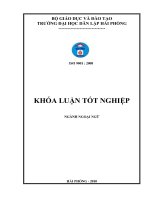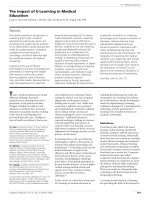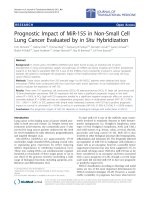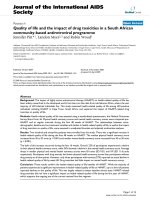Impact of internal marketing on turnover intention of SME staff in service industry in Hanoi, Vietnam
Bạn đang xem bản rút gọn của tài liệu. Xem và tải ngay bản đầy đủ của tài liệu tại đây (510.45 KB, 9 trang )
IMPACT OF INTERNAL MARKETING ON TURNOVER INTENTION
OF SME STAFF IN SERVICE INDUSTRY IN HANOI, VIETNAM
Dr.Le Thuy Huong
Faculty of Business Administration, Hanoi University of Industry, Hanoi, Vietnam
Dr.Cao Thi Thanh
Faculty of Business Administration, Hanoi University of Industry, Hanoi, Vietnam
Dr.Hoang Thanh Tung
Faculty of Business Administration, University of Labor and Social Affairs
Abstract
The role of internal marketing has been confirmed through many researches in
various fields. This article explores the relationship between some elements of internal
marketing and the turnover intention of SME‟ employees in service industry in Hanoi. The
study was carried out by quantitative method with a sample of 818 workers. The findings
confirm that Leadership, Pay Satisfaction and Person-Organizational Fits significantly
impact turnover intention. The Working environment was found to have no impact on
Turnover intention in service industry. The result of the study adds to the expertise of
human resource service managers in keeping employees in business.
Keywords: internal marketing, leadership, pay satisfaction, person-organization fit,
service industry, SME, turnover intention, working environment.
1. Introduction
In the international globalization, competitions among enterprises have become
more challenge. It is difficult to recruit but how to retain them is more difficult. During last
years, staff turnover has become a big issue of many organizations, especially in SMEs
where their resources must be prioritized on production or business development in order
to create more profit rather than resources spent to keep or retain their employees.
Moreover, in SMEs of services industry in which it requires their employee‘s commitment
than the other industries because the service‘s quality demonstrates on their employee‘s
behavior. When the employee has less organizational commitment, it affects directly their
service‘s quality, it means it affects their business reputation and turnover. This industry
requires the number of employees, in the meantime, its staff turnover rate is always higher than
the others because of this industry‘s nature as its diversity in the labor, seasonal services, it‘
staff has more job opportunities and unstable labor forces. Labor forces play an important role
because they are objects to transform every message, corporate culture and the nature of the
industry. The service industry‘s quality is demonstrated on its labor force‘s quality. The more
labor force has changes, the more quality of the industry is affected.
1010
Most conventional marketing researchers focus on external customers to business
organizations and explore methods of retaining external customers. However, for service
providing organizations, services provision is from internal customers to external
customers with intangible or tangible services. The organizational service quality thus is
affected by the service contents from internal customers and the employee‘s service
attitude. Internal marketing issues thus have started to become the focus of research on
marketing, strategies and organizations. Particularly, service organizations should pay
increased attention to internal marketing, because employees must contact and interact
with customers when providing service. Internal marketing practices aim to attract and
retain the most qualified and committed employees for the organization. In a serviceproviding organization, this translates into eliciting service-oriented behaviors designed to
achieve high customer satisfaction and loyalty (Kim, 2016; Barnes & Morris, 2000).
Service organizations create service values for external customers by interacting with
employees and delivering service value to external customers. Bansal et al. (2001) posited
that internal marketing can improve employee organizational loyalty and job satisfaction.
Internal marketing also attracts and organizes talent, and helps business organizations
improve employee service capabilities (Berry, 1984). Internal marketing is gaining
increasing recognition in both the academic and commercial arenas through enhancing
both customer and employee satisfaction (Lings, 1999).
2. Litteratural review
Internal Marketing
Internal marketing is an application of marketing philosophy and method with the
purpose of stimulating employees to complete the tasks (Greene, Walls, & Schrest, 1994).
Palmer (2001) defined internal marketing as the application of the principles and practices of
marketing to an organization‘s dealings with its employees. Internal marketing treats the
employee as an internal customer, regards jobs as products, and intends to satisfy the
employee‘s demands through products (Longbottom et al., 2006). Kotler and Armstrong
(1991) viewed internal marketing as the building of customer orientation among employees by
training and motivating both customer-contact and support staff to work as a team. Zeithaml
and Bitner (2000) indicated that in the Golden Triangle model of service, external marketing
aims to construct commitment, interactive marketing aims to fulfill commitment, and internal
marketing aims to enhance an employee‘s ability to fulfill commitment. Although external and
interactive marketing are important, internal marketing places greater value on internal
employees‘ human resources management and applications.
Research Objectives and Importance of the investigation Significance Internal
marketing is especially important for service organizations (Greene et al., 1994), because
service companies generally maintain contact with customers via their employees, most
service industry organizations are highly labor-intensive and internal marketing is helpful
for such organizations in attracting and ensuring high involvement of high quality talent
(Berry, 1984).
Internal marketing is based on the notion that organizations providing
secure employment are committed to their workforce.
1011
Gronroos (1994) asserted that without active and continuous internal marketing
efforts, the interactive marketing impact on customers will deteriorate, service quality will
suffer, and customers will start to defect with negative effects on profitability as a result.
Gummesson (2000) suggested that internal marketing is a strategic operation that combines
marketing and human resources management in order for first-line service personnel to provide
the best service when interacting with customers. Joseph (1996) suggested that internal
marketing motivates, mobilizes, recruits, and manages employees by using marketing and
human resource management approaches to continuously improve services to employees,
which was consistent with Kotler and Levy (1969), who defined internal marketing as follows:
firms successfully hire, train, and motivate employees to provide better service to customers. In
summary, internal marketing embraces the notion that a company should treat its internal
employees as external customers in satisfying their needs. Thus, through management
satisfying the needs of internal customers, employees become more motivated and committed
to the company, which leads to external customers being well served (Barnes et al., 2004).
Many academic studies in the internal marketing literature identified key elements of
internal marketing, including Conduit and Mavondo‘s (2001) market training and education,
management support, internal communication, personnel management, and employee
involvement in external communication; Ahmed, Rafiq, and Saad‘s (2003) top management
support, business process support, and cross-functional coordination; Tsai and Tang‘s (2008)
service training programs, performance incentives, and vision for service excellence. In this
study, four factors represent internal marketing will be test. Those are: Leadership (LS),
Person-Organizational Fits (POF), Pay Satisfaction (PS) and Working Environment (WO).
Leadership
Leadership is the way the leader gives the direction, plan and motivates the others in the
enterprise. It is the leading way for their employee to achieve the company‘s objectives. The
leader who is mirror of their employee, transform to the others by their action plans and
directions in the future (Podsakoff, MacKenzie, Moorman & Fette‘s (1990).
Person-Organizational Fits
POF is the fit between an individual and organization (supplementary and
complimentary fits). It is additional same characters (Muchinsky & Monahan, 1987,
p.269). Supplementary occurs when an individual‘s characters add the whole or a part to
what is that organization (Muchinsky & Monahan, 1987, p 271).
Pay Satisfaction
Pay Satisfaction is with salary, the way to pay, C&B policy or process and term of
payment as well as other bonus or allowance (in-direct benefits) to the employee
(Heneman, 1985).
Working Environment
According to Balzer et all (1997), Dabke et all (2008), WE is the place where the
employee can expose their ideas, the place where they are equipped necessary working
tools to work, where they can work in fresh air and independently. This is the working
1012
condition to facilitate the employee so that they can work more effectively and enhance
there commitment to the organization.
Turnover Intention
Turnover intention is the intention to leave the current working environment to
move to another working environment. According to some studies, there are many reasons
to leave an organization, such as retirement or relocation, but the most common reasons are
when employees see leadership or managerial behavior. Incorrect or not good work,
inconvenient work for development (no chance of development or promotion),
unreasonable wages and bonuses (Janet Cheng Lian Chew, 2004).
Turnover is a process where employees leave a job or leave an organization. The
turnover intention is to measure whether an employee plans to leave their position or
whether the organization plans to change the employee from that position. Turnover
intention, like the very nature of leaving, may be voluntary or involuntary. The voluntary
turnover intention of the organization will occur when the employee decides to leave his or
her organization. This action occurs when the employee receives a better job opportunity
than the current job. This also includes reasons for being paid higher, more credited, or to a
more advantageous organization. It can also occur due to health or family factors of the
employee. If an employee plans to leave his or her job, it is obvious that they intend to
leave voluntarily (Dess & Shaw, 2011).
In contrast, involuntary turnover intention organization is measured whether the
organization plans to fire or replace the employee from the job, and this will inevitably
result in leaving the organization. This usually happens when an organization is
dissatisfied with the employee, dissatisfied with the performance of the employee and
seeks to replace the employee. It also happens when businesses want to cut back on excess,
unimportant (non-value-generating) positions due to economic downturns or termination of
operations (Dess & Shaw, 2011). In summary, involuntary departure is the decision of the
employer not to employ such personnel.
There are not many studies examining the relationship between internal marketing
and the intention to leave the business. Especially in the service sector, this issue has not
been considered much. Therefore, the author studies the relationship between some
elements of internal marketing and the intention to leave the business of SME employees
in the service sector in Hanoi, Vietnam through the following model:
Leadership
Working Environment
Turnover
Intention
Pay Satisfaction
Person-Organization Fit
Proposed research model
1013
Research hypotheses:
(H1) Leadership impacts negatively to turnover intention.
(H2) Working Environment impacts negatively to turnover intention.
(H3) Pay Satisfaction impacts negatively to turnover intention.
(H4) Person-Organization Fit impacts negatively to turnover intention.
Measure
Turnover intention scale was adopted from Meyer Angle, Perry (1981) và Jenkins (1993).
Leadership scale was adopted from Podsakoff, MacKenzie, Moorman, and Fette‗s (1990).
Working Environment scale was adopted from Nazim Ali (2010).
Pay Satisfaction scale was adopted from Weiss, Dawis, England and Lofquist (1967).
Person-Organization Fit scale was adopted from Cable and Judge(1996).
3. Method
The study was conducted by quantitative method through a survey. Data collection
was used to evaluate the scales, factor analysis, and model testing and hypotheses by
means of multiple regression with the support of SPSS software version 20.
To achieve the objective of the research, within limited capabilities and resources, the
authors selected sampling probability (non-stratified random selection). According to a
delimitation of the Ministry of Planning and Investment on the small and medium enterprises
operating in services sector includes various fields such as the health sector, education,
information technology, transportation, management consulting ... Based on this classification,
the authors randomly selected small and medium enterprises in the fields as stated above to
ensure the extensiveness of enterprises in different sectors in the service industry.
To ensure the representativeness of the sample, the authors have tried to select the
sampling units in the small and medium enterprises in the service sector in different
geographical areas of Hanoi, not just focused on districts at the center of Hanoi.
The data collection took place at locations predetermined list, the author delivered
the questionnaire to employees in such enterprises above. Total questionaires was 1,000;
915 were collected, and valid ones were 818.
4. Results
4.1. Testing value and reliability of measuring scales
Results show that KMO = 0.711 which meets the condition of KMO > 0.5 (Kaiser,
1974). So, we could conclude that the factor is appropriate with available data. By the
same way, test result Barlett shows that p = 0.000 < 5%, which means variables have
relationship with each other and meet conditions to analysis factors by EFA examination.
Results showed that from 38 items of can extract 4 independent variables. The total
variance which is explainable as extracting factor group is 75.175% (> 50%).
1014
EFA shows that LS is loaded in one factor. All of load coefficients meet defined
standards (>0.6) and shows that observing variables have significant relationships with
each factor. All items of POF is loaded in one factor, the lowest is 0.821, highest 0.842, it
means it has significant relationship with POF. PS with 14 items are loaded in one factor,
all is 0,662 above, as a result, observing variables have significant relationship with PS. All
items of WE are loaded in one factor and it has significant relationship.
The result shows that Cronbach Alpha value and total variable correlation
coefficient meets standards (>0.7). Therefore, these are good measuring scale with close
correlation with each other‘s in order to measure independent and dependent variables.
These scales guarantee reliability and may be used for following analysis.
4.2. Hypothesis test and regression analysis
The result illutrates that the adjusted coefficient R2 of the model is 0.218. Thus, the
independent variables were able to explain 21.8% of the variation of turnover intention.
The F test result of the model shows that F = 24.542, sig = 0.000. Thus, this
relationship assures the reliability with a permissible level of 5%. Therefore, it is possible
to conclude that independent variables have an impact on turnover intention and a linear
multiple regression model that is consistent with the data set and is usable.
The results of the multi-collinearity test of the model show that the variance
inflation factors VIF in this model are <2. Therefore, multicollinearity property of
independent variables is insignificant and variables in the model may be accepted
The results of the regression analysis also show that:
- Sig value of Leadership factor < 0.05, so we could accept hypothesis H1
Leadership impacts negatively to turnover intention.
- Sig value of Working Environment factor > 0.05, so we could reject hypothesis
H2. Working Environment impacts negatively to turnover intention.
- Sig value of Pay Satisfaction factor < 0.05, so we could accept hypothesis H3. Pay
Satisfaction impacts negatively to turnover intention.
- Sig value of Person-Organization Fit factor < 0.05, so we could accept hypothesis
H4. Person-Organization Fit impacts negatively to turnover intention
The relationship between dependent and independent variables is shown in the
following linear regression equation:
Y = -0,250X1 - 0,214X2 - 0,139X3
Y: Turnover intention
X1: Leadership
X2: Pay Satisfaction
X3: Person-Organization Fit
1015
The regression equation shows that normalized Beta coefficients of independent
factors are all < 0, which means independent variables negatively influence to turnover
intention. Thus, according to the above equation, when an entity turnover intention
increases, then there must be a negative resonance of 0.250 Leadership, 0,214 Pay
Satisfaction, and 0,139 Person-Organization Fit.
5. Discussion and implication
Hypothesis H1 is accepted, confirming Leadership impacts positively to turnover
intention. The better the leader, the less the intention to leave the company. Leadership is
the way the leader gives the direction, plan and motivates the others in the enterprise. It is
the leading way for their employee to achieve the company‘s objectives. The leader who is
mirror of their employee, transform to the others by their action plans and directions in the
future. When leaders have a positive leadership style, respecting employees and creating
good working conditions for employees, employees will want to stay. Especially in the
SME service industry, the leader often has direct supervision to employees, so the
leadership style is more influence on the intention to connect or leave the business.
Therefore, the leaders of SME service industries need to choose an positive leadership
style and towards the retention of employees.
Hypothesis H2 is rejected, so there is not enough evidence to conclude that Working
Environment impacts positively to turnover intention. Working Environment is the place
where the employee can expose their ideas, the place where they are equipped necessary
working tools to work, where they can work in fresh air and independently. This is the working
condition to facilitate the employee so that they can work more effectively and enhance there
commitment to the organization. However turnover intention does not come from internal
factors, but also from external factors, such as other firms offering higher salaries or more
suitable jobs. Especially with the SME service sector, because of the small size of the
company, the working conditions are not the best. Besides the service sector is the industry
where competitors often attract good employees from other businesses Therefore, good
working environment does not explain the intention to leave the company.
Hypothesis H3 is accepted, confirming Pay Satisfaction impacts positively to
turnover intention. Thus, employees are more satisfied with the income from the business,
the less they intend to leave the business. Pay Satisfaction is with salary, the way to pay,
compensation and benefits policy or process and term of payment as well as other bonus or
allowance (in-direct benefits) to the employee. Employees in general and SME service
workers in particular exchange their labor for income. Getting a decent income will help
them want to stick with the job, and reduce the intention to leave the business. In the
service sector, in addition to basic salary, employees also receive bonuses from businesses
and customers when they perform well. So income from work is really a factor that helps
keep employees. Managers of SME service businesses should pay attention to
compensation and benefit to increase the level of commitment and minimize the
employee's turnover intention.
1016
Hypothesis H4 is accepted, confirming Person-Organization Fit impacts positively
to turnover intention. So when employees find themselves fit for the organization, the less
their intention to leave their business. Person-Organizational Fits is the fit between an
individual and organization. Different service sectors have different organizational
characteristics and job characteristics. When employees feel they are fit for the
organization, they feel they are able to match their job requirements, working conditions fit
their desires, job characteristics fit their interests. They will enjoy the work more and
devote more to the work and the company. In other words, they will work with passion and
will want to stick with the business. Thus reducing turnover intention. As a result, SME
service industry executives need to do well in internal marketing by creating a fit between
employees and work, between employees and the organization.
References
1. Ahmed, P. K., Rafiq, M., & Saad, N. M. (2003). Internal marketing and the mediating role of organizational competencies. European Journal of Marketing, 37(9), 1221-1241.
2. Angle, H.L., and J.L. Perry, (1981), 'An empirical assessment of organizational
commitment and organizational effectiveness', Administrative Science Quarterly 26: p. 1-13.
3. Balzer et all, (1997), User‘s manual for the Job Descriptive Index (JDI; 1997 Revision)
and the Job in General (JIG) Scales. Bowling Green State University. United States.
4. Bansal, Harvir, S, Mendelson, Morris B., Sharma, Basu,‖The impact of internal
marketing activities on external marketing outcomes‖, Journal of Quality Management, 6,
pp 61-76, 2001.
5. Barnes, Brandley R. & D.S. Morris,‖ Revising quality awareness through internal
marketing: an exploratory research among French and English medium-sized enterprises‖,
Total Quality Management, 11(4), S473-S483, 2000.
6. Barnes, B. R., Fox, M. T., & Morris, D. S. (2004). Exploring the linkage between
internal marketing, relationship marketing and service quality: A case study of a consulting
organization. Total Quality Management and Business Excellence, 15(5/6), 593-601.
7. Berry, L.L., Services marketing is different. In: Lovelock Christopher H, editor.
Services Marketing. Prentice-Hall, Englewood Cliffs, NJ, 1984.
8. Cable và Judge, (1996), 'Person–Organization Fit, Job Choice Decisions and
Organizational Entry', Organizational behavior and human decision processes, Vol. 67, No.
(3), p. 294–311.
9. Conduit, J., & Mavondo, F. T. (2001). How critical is internal customer
orientation to market orientation. Journal of Business Research, 51(1), 11-24.
10. Dabke, S., Salem, O., Genaidy, A., and Daraiseh, N, (2008), 'Job Satisfaction of
Women in Construction Trades', J. Constr. Eng. Management., p. 205-216.
11. Dess GD and Shaw JD, (2001), 'Voluntary Turnover - social capital and
organizational performance', Academy of Management Review. Vol 26 (3). p. 446-456
1017
12. Greene, W.E., Walls, G.D. & Schrest, L.J.,‖ Internal marketing: the key to
external marketing success‖, Journal of Services Marketing, 8(4), pp5-13, 1994.
13. Gronroos, C. (1994). From scientific management to service management.
Interna- tional Journal of Service Industry Management, 5(2), 5-20.
14. Gummesson, E. (2000). Internal marketing in the light of relationship marketing
and network organizations. In R. J. Varey & B. R. Lewis (Eds.), Internal marketing:
Directions for management (pp. 27-42). New York: Routledge.
15. Heneman, H. G. III, & Schwab, D. P., (1985), 'Pay satisfaction: Its
multidimensional nature and measurement', International Journal of Psychology, 20, p.
129-142.
16. Janet Cheng Lian Chew, (2004), 'The influence of human resource management
practices on the retention of core employees of Australian organisations: an empirical
study'. PhD thesis, Murdoch University.
17. Joseph, W. B. (1996). Internal marketing builds service quality. Journal of
Health Care Marketing, 16(1), 54-59.
18. Kotler, P., & Armstrong, G. (1991). Principles of marketing (5th ed.).
Englewood Cliffs, NJ: Prentice Hall.
19. Kotler, P., & Levy, S. J. (1969). Broadening the concept of marketing. Journal
of Marketing, 33(1), 10-15.
20. Muchinsky & Monahan, (1987), 'What is person-environment congruence?
Supplementary versus complementary models of fit', Journal of Vocational Behavior,
Volume 31, Issue 3, p. 268-277.
21. Lings, Ian N.,‖Managing service quality with internal marketing schematics‖,
Long Range Planning, 32(4), pp 452-463, 1999.
22. Longbottom, D., Osseo-Asare, A. E., Chourides, P., & Murphy, W. D. (2006).
Real quality: Does the future of TQM depend on internal marketing? Total Quality
Management & Business Excellence, 17(6), 709-732.
23. Palmer, A. (2001). Principles of services marketing (3rd ed.). Berkshire, UK:
McGraw Hill.
24. Podsakoff, P. M., MacKenzie, S. B., Moorman, R. H., & Fetter, R. (1990),
'Transformational leader behaviors and their effects on followers‘ trust in leader, satisfaction,
and organizational citizenship behaviors', Leadership Quarterly, 1: p. 107–142.
25. Tsai, Y., & Tang, T. W. (2008). How to improve service quality: Internal
market- ing as a determining factor. Total Quality Management and Business Excellence,
19(11), 1117-1126.
26. Zeithaml, V. A., & Bitner, M. J. (2000). Services marketing (7th ed.). New
York: McGraw-Hill.
1018









